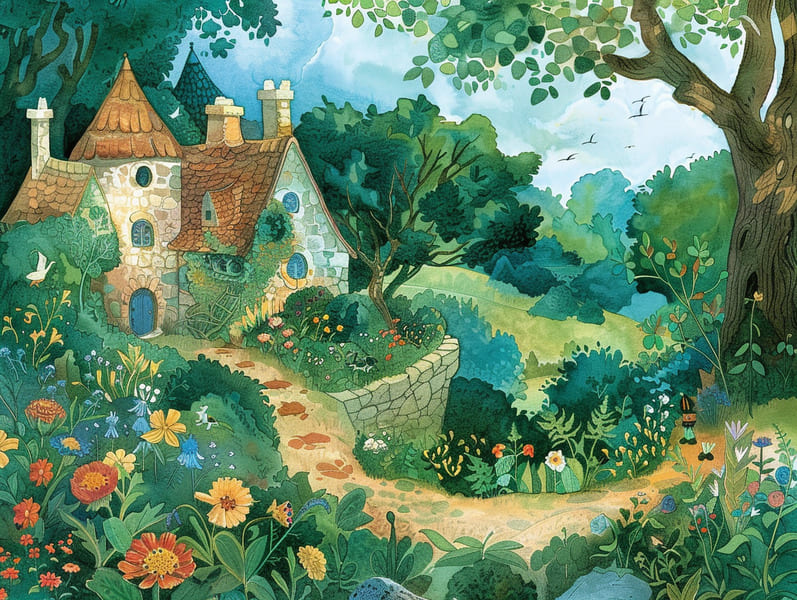The Creation of Grimm's Fairy Tales and Their Eternal Magic.
The Creation of Grimm's Fairy Tales and Their Eternal Magic.
Blog Article

Grimm's fairy tales have ancient roots. These stories have been whispered from one generation to the next ages before they were ever written down. They originated from a variety of backgrounds, including Western traditions. They were initially told among older generations, often carrying themes and messages pertaining to the societal norms and beliefs of the time.
The renowned Brothers Grimm, the two Grimm brothers, were among the first to compile many of these beloved tales. Their anthology, "Grimm's Fairy Stories," included stories like "The Little Glass Slipper," "Hansel and Grethel," and "Little Snow White," which have since become hallmarks in the world of beloved fairy tales. Similarly, H. C. Andersen's fanciful tales, such as "The Sea Maid," and "The Story of the Ugly Duckling," have floated into hearts worldwide, securing their place in the pantheon of famous fairy tales.
Despite being ancient, traditional fairy tales remain as relevant as ever, especially as children's night stories. These charming stories are now available in diverse formats, including vibrantly illustrated books, enchanting animations, and online fairy tales.
Their ongoing significance can be traced to several delightful features:
Significant Morals: Ancient fairy tales often share important moral lessons. Fairy tales like "The Shepherd Boy and the Wolf" teach the value of truth, while "The Race of the Tortoise and the Hare" underline the values of resolve and modesty. These narratives offer children clear distinctions between ethical and unethical, building their moral compass in a tender yet lasting way.
Empathy and Awareness: Fairy tales frequently involve individuals facing trials and tribulations, motivating readers to resonate with their struggles and back their triumphs. For instance, "Beauty's Beast" points out the value of seeing inner beauty to recognize the true nature of a person, strengthening awareness and discernment.
Cultural Comprehension: Many fairy tales are rich in the cultural contexts from which they came. Learning from these narratives can provide captivating looks into different heritages, fostering a sense of world appreciation and awareness.
Imagination and Innovation: The imaginative elements in ancient fairy tales—mythical creatures—fuel children’s fantastical thinking. These narratives move readers to supernatural realms, enhancing creative ideas and a sense of magic that persists a lifetime.
Old fairy tales are not only magical but also didactic. They serve as entrancing tools in developing various cognitive and affective skills in kids. When fairy tales are voiced, they develop speech development by presenting new words and intricate sentence structures. This practice also nurtures listening skills and focus, as young readers track the narrative, excited to see what happens next.
Furthermore, examining the themes and characters of ancient fairy tales can advance intellectual skills and evaluative skills. Little ones are taught to pinpoint patterns, foresee events, and understand cause and effect. These contemplations also encourage young readers express their thoughts and feelings, promoting their emotional intelligence.
In today’s digital age, the availability of online fairy tales has made these narratives more attainable than ever. Internet resources and digital apps offer huge assortments of timeless fairy tales that can be looked at or heard anytime, anywhere. Fairy tales recited are particularly popular, supplying an delightful method for kids to immerse in these charming stories. Audio stories and read-out-loud stories move characters and settings to life, often accompanied by delightful melodies and songs that enhance the storytelling experience.
The timeless fascination of old fairy tales lies in their ability to evolve to current times while staying true to their underlying messages. Contemporary retellings of these narratives often spotlight more multicultural protagonists and modern settings, making them familiar to today’s audience. However, the underlying themes of valour, warmth, and impartiality remain unchanged, continuing to touch kids of all ages.
Timeless fairy tales also offer a sense of assurance and knowability. They afford a well-arranged narrative with a clear beginning, middle, and end, often drawing to a close with the wrap-up of conflicts and the triumph of good over evil. This assuredness can check here be comforting for kids, sharing a sense of assuredness in an shifting world.
Timeless fairy tales continue to allure and coach new generations, maintaining their radiance and impact in modern society. As children's night stories, they bequeath a perfect blend of delight and instruction, boosting moral values, empathy, and creativity. The prevalence of internet fairy tales and the in demand status of fairy tales narrated certify that these timeless tales remain available to new generations.
By keeping and releasing these narratives, we continue to laud the rich tapestry of mythology and cultural heritage. Whether you are enjoying a vividly illustrated book, delving into a web collection, or listening through an read-aloud story, the splendor of children's fairy tales is always within reach. These narratives reveal of the everlasting spell of tales and its ability to connect us across eras and regions.
Regardless if you are perusing a vividly illustrated book, experiencing a online library, or listening on an voice book, the appeal of ancient fairy tales is always within reach.
These fairy tales remind us of the unfading magic of stories and its ability to bring us together across eras and regions, making a tie that fascinates and enlightens alike.